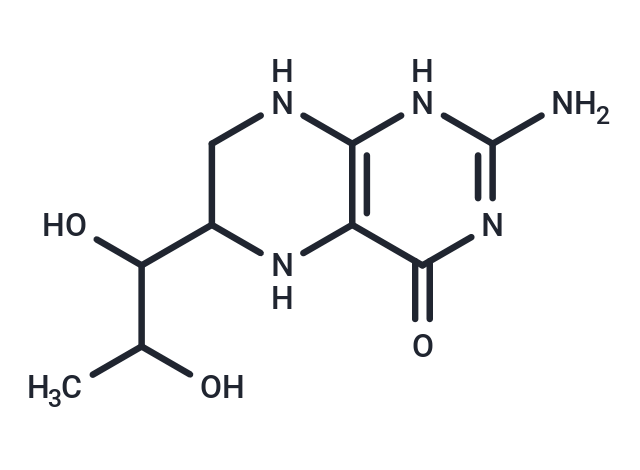Shopping Cart
Remove All Your shopping cart is currently empty
Your shopping cart is currently empty
Tetrahydrobiopterin (BH4) is a cofactor for aromatic amino acid hydroxylases and an essential cofactor for nitric oxide synthase (NOS), which is used in the study of endothelial dysfunction such as hypertension, hypercholesterolemia, and diabetes.

| Pack Size | Price | USA Warehouse | Global Warehouse | Quantity |
|---|---|---|---|---|
| 1 mg | $40 | 7-10 days | 7-10 days | |
| 5 mg | $87 | 7-10 days | 7-10 days | |
| 10 mg | $125 | 7-10 days | 7-10 days | |
| 25 mg | $198 | 7-10 days | 7-10 days | |
| 50 mg | $297 | 7-10 days | 7-10 days | |
| 100 mg | $453 | 7-10 days | 7-10 days | |
| 200 mg | $694 | 7-10 days | 7-10 days | |
| 1 mL x 10 mM (in DMSO) | $98 | - | In Stock |
| Description | Tetrahydrobiopterin (BH4) is a cofactor for aromatic amino acid hydroxylases and an essential cofactor for nitric oxide synthase (NOS), which is used in the study of endothelial dysfunction such as hypertension, hypercholesterolemia, and diabetes. |
| In vitro | Microglia cultures under hyperoxic conditions were supplemented with or without Tetrahydrobiopterin (100 μM). Exposure of microglia to hyperoxia-induced oxidative stress for 24 h showed a significant increase in TSP-1 mRNA expression and protein compared with normoxia (21% O2). Tetrahydrobiopterin supplementation significantly prevents hyperoxia-induced microglial activation and prevents microvascular damage in choroidal explants by reducing Iba-1 and TSP-1 expression.[1] |
| In vivo | To assess the levels of tetrahydrobiopterin in the retina, three to five retinal pools were collected from WT and HPH-1 mice at postnatal ages 7, 14, and 22 years and evaluated by LC-MS/MS. LC-MS/MS analysis confirmed that the concentration level of tetrahydrobiopterin in the retinal tissue of HPH-1 mice was significantly reduced by approximately 90% compared with WT groups P7, P14, and P22, respectively.[1] |
| Synonyms | Sapropterin, BH4, (Rac)-Sapropterin |
| Molecular Weight | 241.25 |
| Formula | C9H15N5O3 |
| Cas No. | 17528-72-2 |
| Smiles | CC(O)C(O)C1CNc2[nH]c(N)nc(=O)c2N1 |
| Relative Density. | 1.31g/cm3 |
| Storage | store at low temperature,keep away from direct sunlight | Powder: -20°C for 3 years | Shipping with blue ice/Shipping at ambient temperature. | |||||||||||||||||||||||||||||||||||
| Solubility Information | DMSO: 40 mg/mL (165.8 mM), Sonication is recommended. | |||||||||||||||||||||||||||||||||||
| In Vivo Formulation | 10% DMSO+40% PEG300+5% Tween 80+45% Saline: 2 mg/mL (8.29 mM), Sonication is recommended. Please add the solvents sequentially, clarifying the solution as much as possible before adding the next one. Dissolve by heating and/or sonication if necessary. Working solution is recommended to be prepared and used immediately. The formulation provided above is for reference purposes only. In vivo formulations may vary and should be modified based on specific experimental conditions. | |||||||||||||||||||||||||||||||||||
Solution Preparation Table | ||||||||||||||||||||||||||||||||||||
DMSO
| ||||||||||||||||||||||||||||||||||||
| Size | Quantity | Unit Price | Amount | Operation |
|---|

Copyright © 2015-2025 TargetMol Chemicals Inc. All Rights Reserved.